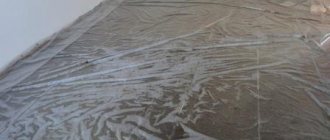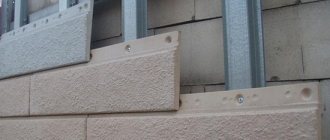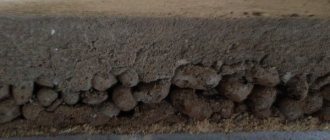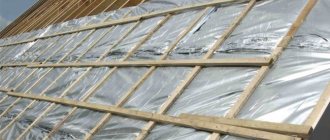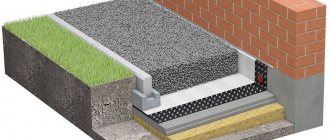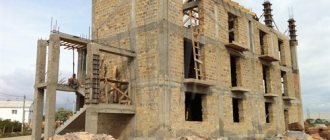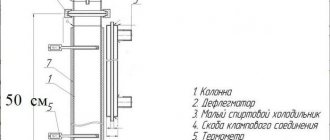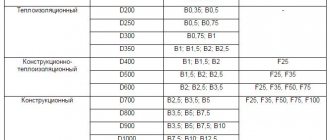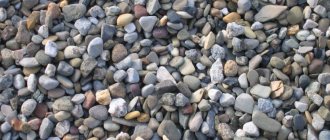The excellent characteristics and composition of sawdust concrete make it possible to use it in the construction of monoliths and small wall blocks of low-rise buildings. Sawdust is a product of organic waste, so the heat transfer of the new building material is greater than that of conventional concrete. Since there is no such material on the construction market, builders make it themselves. However, the requirements of GOST 6133–99 apply to sawdust concrete blocks, as well as to other concrete stones. Therefore, you need to know the manufacturing technology and adhere to the specified proportions.
View "GOST 6133-99" or
Composition and brands
The components of this building material are:
- Cement that acts as a binder, which, in accordance with GOST 10178−85, must not be lower than M400.
- Coarse and medium sand, meeting GOST 8736-93.
- Sawdust of all types of trees, mainly coniferous, amenable to less rotting.
- Additives: lime, clay, ammonium sulfate, liquid soda glass. But the addition of calcium chloride is most suitable for GOST requirements.
- Unpolluted water - GOST 23732–79.
View "GOST 10178-85" or
View "GOST 8736-93" or
View "GOST 23732-79" or
The density of sawdust concrete depends on the amount, first of all, of sand, which, together with other additives, increases the quality indicators of the material.
Sawdust concrete grades
| Name | Density, t/m3 | Coefficient of thermal conductivity |
| M5 | 0,6 | 0,18 |
| M10 | up to 0.8 | 0,21 |
| M15 | 0,8 | 0,24 |
| M20 | 0,95 | 0,3 |
Roof insulation with sawdust
Insulation of the roof and ceiling is a very important and responsible undertaking.
Not many people know that it is through this part of the house that the largest amount of heat comes out.
It is best to do this work in the summer so that your solution dries as quickly as possible and becomes stronger before the onset of cold weather. In order for the mixture to turn out perfectly, certain criteria must be met.
Namely:
- The cement must be seasoned, otherwise the mixture will not set well;
- The sawdust is completely dry;
- There should not be even a hint of mold on the working part;
- Buy sawdust only of medium size, since cement will not fit well on large ones, and this will lead to poor thermal insulation.
The surface of the roof should be covered with parchment or a special film, which will be attached with a stapler. The layer should be applied evenly and lightly compacted. After a few days, you can begin to seal the cracks that formed during the drying process. This can be done using clay. After this, the layer must be left to dry.
Advantages and disadvantages
Concrete with sawdust has unique qualities compared to other building materials:
Despite its simplicity, the material has enviable characteristics.
- environmental safety of use;
- a light weight;
- required heat retention indicators;
- simple processing during construction;
- resistance to tensile and bending strength;
- folk (accessible) composition.
However, there are also disadvantages:
- A sufficient degree of moisture absorption requires work to avoid this.
- Increase in financial costs in the construction of multi-storey buildings due to the addition of cement. A house made of sawdust concrete, which has gained natural strength, will be of better quality than one made of ordinary concrete.
- The high probability of shrinkage makes finishing work difficult.
Types of insulated houses and sawdust mixtures
Insulating walls with sawdust is best done when building low-rise (single-story or attic) houses, in which the attic will be used only in the summer. This will allow sawdust to be added to the floors and walls after they have settled. If the house has an attic, then you can insulate its internal walls.
The binding solution is made from lime or cement mixed with water and an antiseptic.
When insulating with sawdust, there may be an increased danger in the event of a fire on the gables of the building. Because the height of all gables is about 5.5-6 m, and in order to leave free space for sawdust, fireproof bulkheads will have to be removed. They need to be installed if the height of the walls is more than 3 m. And in their absence, an increased draft will occur, which is very dangerous. To ensure the addition of sawdust under the windows, you need to make removable window sills.
Sawdust, as insulation, must be of a large fraction, which is formed when cutting wood on sawmills or similar devices. The sawdust remaining after processing in furniture production will be very fine and not suitable for insulation. It often uses materials such as OSB plywood, chipboard or MDF. In addition to the fine fraction of these sawdust, they are also environmentally unsafe, since various chemical compounds are used in their processing.
When laying sawdust in the walls, you need to keep it dry. Increased humidity will lead to the formation of fungus and mold, which will subsequently affect all walls. In order for sawdust, as insulation, to harden and compact better, gypsum can be added to the total volume. Its percentage should be 5% of the total mass of the material. But gypsum hardens very quickly, so it is not recommended to prepare such a mixture in large quantities. It can be replaced with ordinary cement, and of the lowest grade. A mixture of sawdust and cement will take a little longer to harden, but it will be much easier to lay. Moreover, the cement will in the future draw out all the moisture from the sawdust, which will lead to its hardening.
What is the consumption and proportions?
Characteristics of volume in buckets per 1m3 for each grade of sawdust concrete
| Name | Sawdust | Sand | Cement | Lime or clay | Proportions (cement, sand, sawdust, lime) |
| M5 | 80 | 3 | 4,5 | 14 | 1:0:2:1 |
| M10 | 80 | 12 | 9,5 | 10,5 | 1:2,2:6,5:1,5 |
| M15 | 80 | 21 | 13,5 | 7 | 1,2:3:7,8:0,8 |
| M25 | 80 | 30 | 18 | 35 | 1:2,8:6,4:0,8 |
Making sawdust mixture
There are no exact recipes for making such mixtures. All of them are prepared individually. But an approximate composition that is suitable for insulating a house in many cases is as follows:
A sawdust block is made from sawdust and a binding solution.
- Mix 9-10 buckets of sawdust with 1 bucket of lime.
- Add 8-10 liters of water with boric acid or copper sulfate diluted in it (as an antiseptic). Water must be added gradually, and its final amount will depend on the initial moisture content of the sawdust.
- Infuse the prepared mixture for 5-10 minutes. Next, fill it. It is very important that the walls remain steam-tight. Therefore, you cannot use roofing felt or linochrome; it is better to use glassine.
The resulting mixture must be laid in layers. The layer should be small and be 25-30 cm. It should be laid evenly and then compacted. After compaction, further layers need to be laid until the internal space is filled. In some cases, you can use a mixture of sawdust and lime. This insulation composition will cost more than previous compositions. But it will have less hygroscopicity. This means that it will cake less and will require less bedding in the future.
How to prepare the solution?
By choosing any of the two manufacturing methods, you can obtain high-quality material.
For the construction of residential buildings and outbuildings, it is not difficult to make sawdust concrete with your own hands. There are 2 ways to connect components:
- Dilute it into cement in water, and then add the rest of the ingredients.
- Mix the dry substances and dilute with water.
There is no advantage to choosing a cooking option. It is important that a homogeneous structure is formed, which includes sand and cement, forming cement stone. If you make it yourself, you won’t need a concrete mixer, since the manual method is a convenient, although labor-intensive, process. A properly prepared mixture clenched in a fist does not release drops of water.
What are the disadvantages of sawdust insulation?
The main problem with sawdust is its poor resistance to rats and mice.
If you do not take care of solving this problem in advance, then most likely the insulation will suffer in the near future.
Of course, experts took measures a long time ago and found several ways to combat this deficiency. There are many recommendations and they are all different. But in general, several basic means are used in the fight against rodents.
Namely:
- Slaked lime. It is supplemented with sawdust after it is completely dried. The amount of lime should not exceed 10% of the total mass of sawdust.
- Broken glass. They can be added before the laying process on the surface. Don't forget to take precautions and protect your hands from possible injuries and cuts. This option will be very reliable, but you will need to think about the layout process in advance.
- Tobacco can be an excellent remedy for rodents. After drying, it is added to the sawdust in an amount of 15% of the total mass of the shavings.
Wood shavings are an excellent material that allows you to fill even the most inaccessible places. Of course, before this you must definitely mix them with the main component, for example cement.
Properties
Wood shavings as an insulating material have a number of positive and negative characteristics.
Among the advantages are the following:
- good thermal insulation qualities, since the resin released by the shavings conducts heat poorly;
- environmental friendliness, sawdust is a natural material, therefore it does not contain harmful chemicals and does not cause allergies;
- low cost, because it is a production waste, many woodworking enterprises give it away almost for nothing.
The main disadvantages of sawdust:
- high fire hazard, ignite very quickly;
- when used in their pure form, they can harbor insects and rodents;
- when exposed to moisture they are susceptible to rotting.
Due to significant disadvantages, sawdust is practically not used in its pure form as insulation. To eliminate possible unpleasant consequences, wood shavings are mixed with lime, clay, cement or gypsum. The resulting mixture is sprayed with vitriol or other antiseptic solution.
As a result, the resulting material burns poorly and also repels rodents and insects.
Material calculation
Let's look at an example to find out the average number of blocks required to construct a building. For example, you need to build a house measuring 15x10 m, with a wall height of 3.00 m. The perimeter of the building will be the sum of the lengths of all sides = 15+15+10+10 = 50 m. The area of the building is the perimeter multiplied by the height = 50*3 = 150 m². It is worth considering both the thickness of the masonry and the number of blocks per 1 m2:
- 19 cm - 12.5 pcs
- 39 cm - 25 pcs
- 60 cm - 37.5 pcs.
If you plan to build a house with walls 39 cm thick, the volume of blocks you need will be - 150 * 0.39 = 58.5 m³. And the number of pieces of blocks = 150*25 = 3750 pieces.
This calculation does not take into account the area of the openings. However, this is not critical, because the sawdust concrete safety factor is automatically taken into account.
Insulation with sawdust
Sawdust is shavings formed during wood processing. They are used to insulate walls, floors, roofs of residential or commercial buildings, since they retain heat well. The main advantages of sawdust are low cost and excellent thermal insulation. Of these, wood concrete slabs, sawdust pellets, wood blocks and sawdust concrete are produced industrially. Not everyone knows how to use sawdust for thermal insulation . Clean, unprocessed sawdust is not used for insulation. First of all, they catch fire easily. Secondly, they harbor rodents. The rules for using them as a heat insulator will be discussed in the article. For use as insulation, sawdust is mixed with additional components. For example: lime, cement, gypsum. They must be treated with a solution of copper sulfate or boric acid.
Then the mixture will not burn and no one will start in it. It is excellent sound and thermal insulation. After preparing the insulating mass, sawdust is poured into previously prepared places, tamped in layers and waits for final shrinkage for about 2 weeks , during which it is necessary to ventilate the room.
